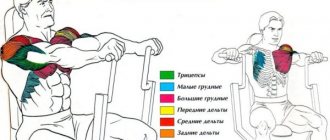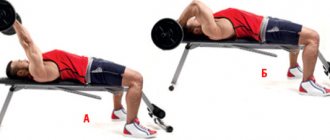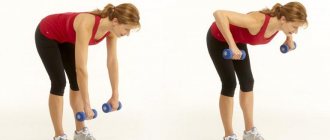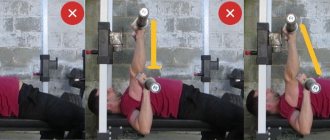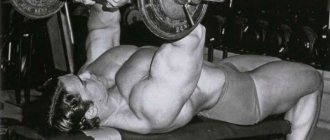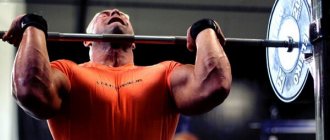Hi all! Today we’ll talk about a basic exercise in bodybuilding – the bench press. Surely everyone who works out in the gym has included it in their training program - including representatives of the fair half of humanity.
For girls, this exercise is also necessary, but they, most often, do not chase the scales, unlike men. But we’ll talk about this in another publication. Not everyone knows how to perform the bench press correctly, because the technique of this exercise directly affects not only the results, but also safety in general.
The step-by-step instructions below will help you perform the bench press correctly, which in turn will allow you to increase your strength in this exercise. So, go ahead.
- Correct hand position
Bench press: general provisions
This is one of three basic exercises that helps develop the chest muscles, triceps of the arms and the shoulder girdle in general. Nothing loads the chest as much as performing this exercise in its various variations.
It is somewhat reminiscent of push-ups, but by using additional weights (dumbbells or barbells) the effect is greatly enhanced.
There are several types of barbell press:
- horizontal;
- on an inclined bench;
- on a reverse-incline bench;
- bench press in powerlifting.
You might think that their technique is 100% similar, but each type has its own subtleties.
Classical
Here the pectoral muscles work over their entire surface, and the triceps and shoulder girdle are secondarily “connected”. It is the classic version of the bench press that allows you to develop a powerful chest. We will look at how to do it correctly step by step a little later. Now I want to show you the starting position:
- lying on a horizontal bench, remove the barbell with both hands;
- while inhaling, slowly lower it to the middle of the chest;
- press the barbell up while exhaling;
During the exercise, we lean on the full sole of our feet. The buttocks are pressed against the bench. The chest is pushed forward. The back is slightly arched.
If you are doing bench presses for the first time, it is better to practice the technique on an empty bar, underweighting the weights until you feel the correct movement. Then you can gradually add weight, still concentrating on technique.
Angle press
For this exercise you will need an incline bench. The technique is similar to the previous version, but due to the 30-degree angle, the main load will fall on the upper part of the pectoral muscles.
How does this press differ from the classic one:
- the barbell should be lowered to an area that is closer to the neck - but not directly on it;
- Here the elbows are brought forward, slightly spread to the sides;
- Be sure to keep your brushes straight, do not tilt them back.
In addition, bodybuilding also suggests that both of these exercises can be performed with dumbbells. In this case, the execution technique is the same, only you still need to make sure that both hands act synchronously and there is no lag.
For all variations of the press, your legs should be kept on the floor, without lifting them up.
Reverse Incline Press
This variation is almost the only exercise that very well pumps up the “undercut” - the lower pectoral muscles. It puts much less strain on the shoulders and lower back than the classic bench press.
It is most effective to choose a bench with an incline of 40-45 degrees. Lie down on it and firmly fix your legs.
Remove the barbell from the racks and slowly lower it to the bottom of your chest as you inhale. Exhale slowly as you squeeze.
In powerlifting
Powerlifting is a discipline where the important indicator for the athlete is the weight taken, and not the aesthetic component. Therefore, an exercise in competitions is performed not for the number of repetitions, but for the maximum weight that the athlete can lift in his weight category.
Here the bench press is the second exercise in the program of any competition. And his correct technique is different from that presented in bodybuilding.
So, the bench press in powerlifting has the following features:
- during execution, the athlete touches the bench with his shoulders and buttocks, making a so-called “bridge” - which is unacceptable in bodybuilding and, in addition, is very dangerous;
- legs are widely spaced and stand as close to the shoulders as possible;
- The bench press is not performed with a narrow grip, but with the widest possible grip – 80 cm or more;
- the movement of the bar should be progressive and not like a jerk.
In addition, you need to monitor the position of your hands - they should not collapse under the weight of the projectile.
Technique
Ideal technique is the main component of success, so you need to closely monitor it. It’s even better to work with a coach or a good partner who will point out mistakes.
The optimal grip width, at which the triceps and chest will be equally involved in the work, is 81 cm. To determine this distance, there are special notches on the bar, they should fall on the middle or ring fingers.
Before the approach, you need to bend as much as possible - the bridge for the power press is very important, back flexibility needs to be trained separately. When doing a bench press, powerlifters have only two points of support - the legs and shoulder blades, while the pelvis only touches the bench, but is not the point of support.
When lowering the barbell, we take a deep breath, and at the exit we sharply and powerfully squeeze the barbell up. You need to lower the barbell to the lower part of your chest, so the movement occurs in an arc.
Technique: step-by-step instructions for the classic press
So, as promised, here are step-by-step instructions for the classic barbell press with proper technique.
Let's start with the placement of the hands and the position of the palms.
Correct hand position
The projectile is taken with both hands located at a distance of 55-65 cm, depending on the length. The longer the arms, the wider the grip.
The thumb must be on the other side of the other fingers and completely wrap around the bar.
Blade position
The shoulder blades must be brought together and lie on the bench. We remove the apparatus from the racks, arms perpendicular to the bench, straighten and then fix the elbows. In this position, the bar should be above your eyes.
Back shape
You should not arch your back, as athletes do in powerlifting. It is enough to just push your chest forward slightly, while not forgetting about the shoulder blades, which should be brought together.
To hold the shoulder blades in this position, pressing your buttocks tightly to the bench will help. Make a slight bend in the lower back and twist your chest with the wheel forward. Thanks to this initial state, the effectiveness of this exercise increases significantly.
Foot placement
During the press, your feet should be in line with your knees and slightly turned out to the sides. The legs should be a rigid support. They should not be lifted, bent at the knees, or carried too far behind the body beyond the pelvis.
Remove the bar from the racks
I recommend not removing the projectile from the racks yourself, especially if the weight is heavy. This is an unnatural movement for the muscles and is also very dangerous. Ask someone to help you do this.
Downward trajectory of the rod
The downward movement is carried out in an arc or with a slight slope. At the lowest point, you do not need to hit the bar on your chest; only a light touch of the lower part of the pectoral muscles is allowed.
Elbow position at the lowest point
While lowering the barbell, you should begin to twist your elbows, bringing them closer to your body. At the bottom point the angle should be 70-75 degrees. The wrists should not fall back during the movement.
Return to original position
At the top point, the elbows must be fully straightened and only then repeat the downward movement of the projectile. An empty bar will help you hone your elbow insertion technique.
Warm-up
Before starting your workout, you should warm up well, no matter if you bench press or squat or perform any other exercises with weights. I recommend running on a treadmill for 10-15 minutes at an average pace to warm up your body and get the blood pumping through it.
If you don’t like running, then do 1-2 sets of 5-7 times with an empty bar. Then, increasing the weight by 10-20 kg, depending on your level of fitness, reduce the number of repetitions until you reach the working weight. The working weight must be performed 8-10 repetitions in 4-6 approaches.
Example of a warm-up with a working weight of 80 kg:
- 20 kg – (5-7) reps;
- 20 kg – (5-7) reps;
- 40 kg – 5;
- 50 – 4;
- 60 – 3;
- 70 – 2;
- 80 – (8-10) reps 4-6 sets.
And this is interesting...
In the life of every person, events can occur that will motivate him to various feats, or, on the contrary, they can suppress a person. The main thing is perception. How does this apply to the bench press? Yes, very simple! Using the example of the life of Ryan Keneally, who was born in a small town and led an unhealthy lifestyle. He didn’t want to study, he was kicked out of baseball, basketball and football teams. And only when he paid attention to such an exercise as the bench press, his life began to change for the better. He chose a regular gym to start with, and it was love at first bench press. Since then, he has only increased his abilities, set goals, and improved his results.
Ryan Keneally is the man whose world record has stood since 2008. What conclusion can be drawn from this? It is not necessary to choose an idol and strive for its results; it is enough to simply love what you do and constantly improve. Find new methods to improve your bench press.
Tips and tricks
- Do not relax your muscles along the entire trajectory of the projectile, especially at the lowest point.
- Do not hold your breath for very long periods of time. On average, 2-3 seconds is enough.
- The heavier the projectile, the stronger you need to exhale.
- Press your feet firmly into the floor and grasp the bar tightly with your palms.
If you work out in the gym without a trainer, then knowing the correct technique is what will ensure not only the success of your training, but also your own safety. However, I would still strongly advise asking someone in the room to back you up and also make sure you do it correctly.
How to increase your performance and overcome the plateau
If you can’t lift heavy weights, but really want to, then there are several tricks for lifting more weight on the barbell.
- Placing your elbows out to the sides when bench pressing is not effective; pressing your elbows closer to your body takes the load off the deltoids and engages more body muscles, which in turn allows you to lift the barbell with more weight.
- Arching your back during the press also allows you to increase the weight on the bar, since arching reduces the range of motion. But don't overdo it.
- Training antagonist muscles also allows you to increase the weight on the bar.
There is equipment for bench press: bench press shirt, slingshot and benchdaddy, wrist wraps, weight bars, press tights.
- The bench shirt is designed to support the athlete, it simplifies the negative phase of the movement and simplifies the lifting of the barbell from the chest, since the weight is retained and the weight is lifted due to the shirt, due to the additional compression created by the shirt, due to the strength of the athlete’s muscles.
- Slingshot and benchdaddy are rubber bands with sleeve or loop stitching. Due to the tension of the elastic elements, they stretch, help support the weight and make it easier for the weight to be lifted off the chest.
- Wrist bandages are wrapped around the hands and firmly fix the hands, preventing the joints from changing their position. The athlete does not need to spend concentration on holding the hands and their grip, which allows adding weight to the bar.
- Weightlifting shoes for weightlifters made of tough leather. A durable rubber sole and a solid heel create solid support for the leg, fix it in one position, and the leg does not deviate to the side when doing the press. This also allows you to avoid distractions on your legs and allows you to add weight to your bench press.
- Press tights allow you to relieve your back and avoid spinal injuries. The tights provide freedom of movement and the athlete can press more weight on the barbell over a greater range of repetitions.
If the weights don’t want to grow, then you should switch to dumbbell presses or presses in a Smith machine. This will put some stress on your breasts. I recommend alternating: do barbell bench presses in one workout, dumbbell bench presses in another, and machine bench presses in a third. You will see, the result will not be long in coming.
It is also necessary to train stabilizer muscles: rear and middle deltoids, biceps, triceps. This will give an impetus to increasing your bench press performance.
The most effective triceps exercise is the French press. It is better to pump your biceps with a barbell, and your deltoids with dumbbells: lifting them in front of you and up.
The bench press is an indicator of an athlete's fitness and strength. Having familiarized yourself with the little tricks, you can set new records, but do not forget about safety precautions.
Working on weak points
After just a couple of months of working on the bench press, it will become clear which part of the amplitude is most difficult for you - lower, middle or upper. The weak point is where you should be working most of the time.
Off the chest
If you have problems with the lower part of the amplitude, that is, breaking the barbell off your chest, then you need to practice paused presses. Lower the barbell to your chest under control, hold it in the down position for one to two seconds, and then push it up powerfully. This exercise develops the explosive power needed to break off the chest.
Passing the "dead spot"
Difficulties can be caused by the middle of the amplitude, when the chest has already switched off from work, but the triceps have not yet turned on. To improve the passage of the “dead point”, presses with a pause are also suitable, since the explosive force will help to pass through a difficult section of the amplitude by inertia. You can also use bar presses - ask a partner to place a 3 or 5 cm thick bar on your chest (most gyms have them) and work in the same manner as with pause presses.
We'll put the pressure on
To practice pressing, work in partial amplitude, lowering the bar to a level just above the “dead point”. Also, with a weak boost, you need to spend more time pumping the triceps.
